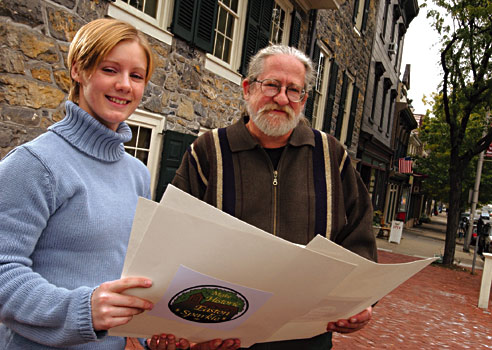A brown bag series continues today on a project that combines engineering and a collaboration between a professional artist and two Lafayette art majors.
The lecture will take place at noon in the Williams Visual Arts Building, where New York artist Wopo Holup has been working with Jackie Bingham ’03 (Lunenburg, Mass.), a double major in art and economics & business, Marisa Damiano ’04 (Easton, Pa.), an art major and French minor, and Lew Minter, director of the media lab, to create and produce digital images using state-of-the-art computers and printers.
Created for The Grass Family (Gramineae), an exhibit on display in the Visual Arts Building lobby through April 19, the digital images are related to a monumental granite sculpture accompanying reconstruction of the Brooklyn Queens Expressway. The $1 million sculpture, “Common Ground,” is considered the largest public art project ever awarded by the State of New York and will be installed in the spring of 2004.
Lisa MacKay, project manager of transportation planning and engineering design for URS Corporation, will talk about the planning and design elements today. The URS engineering firm is serving as consultant to the New York State Department of Transportation on the BQE project.
Last week, Holup discussed the concept for the project and the artistic and engineering efforts that went into designing the sculpture’s panels, determining how they should be cut to fit a curved surface, deciding how they will be hung, and other issues.
Plans also are underway to host a talk by Peter Franco, project manager of construction activities for Slattery/Skanska, about his role as construction manager of the project.
Free and open to the public, the lectures are sponsored by Lafayette’s engineering program.
The engineering project involves design and construction of an overpass for the Brooklyn-Queens Expressway at Northern Boulevard in Queens. Holup’s sculpture is comprised of one-by-one-meter granite panels, each about an inch thick, that will cover the abutments of the overpass. The panels will be adorned with reliefs of grasses and plants, similar varieties of which will landscape the interchange.
Drawings created by Holup at the Visual Arts Building are being used by Johnson Atelier Technical Institute of Sculpture in Mercerville, N.J., to cut the granite panels for the expressway sculpture. Scanned images of the drawings have been used to create The Grass Family.
“Collaborating with Lew and the students in the process of creating these digital images has been a wonderful opportunity,” says Holup. “I couldn’t have done it without them — it was a team effort to produce this exhibit.”
“The scanned images are printed using archival inks on canvas and stretched over old-fashioned stretcher bars.” Holup explains. “Interestingly, the digital images look more real than the actual granite sculpture — there’s a dramatic illusion of three-dimensional depth.” The exhibit, at half-scale of the actual sculpture, is 75 feet long and eight feet high and consists of 164 panels.
The Grass Family also incorporates a selection of computer-generated renderings of the art wall site from URS Corporation.
Following its run at Lafayette, Holup plans to display the exhibit in several museums around the country. In spring 2004, it is scheduled to be installed at the Queens Museum, coinciding with placement of the granite sculpture.
Holup learned of Lafayette’s artistic resources through friend and fellow New York artist Ron Janowich, who accompanied her for a tour of the facilities and introduced her to Ed Kerns, Eugene H. Clapp ’36 Professor of Art and director of the Williams Visual Arts Building. Janowich interacted with students, created digital images, and exhibited the art during a residency based in the building last fall (see related story).
“The most successful things are being done when people interact with each other,” says Holup of her opportunity to work with Lafayette’s students and state-of-the-art equipment. “The technology is not replacing any traditional forms of making art, it’s just another tool for the artist.”
“Wopo’s one of the most amazing people I’ve ever met,” says Damiano. She adds that she has learned technical skills from Minter through the project, along with a close-up view of how a working artist plans a project and an exhibit. “It’s been a really great opportunity.”
“Wopo is great,” adds Bingham, whose work on the project is part of an independent study with Minter that also has included creation of a marketing campaign to clean up downtown Easton (see related story). “She’s very friendly and extremely interested in what we can do with the computers.”
Holup was chosen from a pool of 75 artists to create “Common Ground” by the New York State DOT. The sculpture, of carved granite with bronze bands, will be featured on two large walls, each 16 feet high and 150 feet long. It symbolizes the ethnic diversity of the area, showing a cross-section of a landscape, with depictions of indigenous Queens trees and, below them, grasses from countries around the world symbolizing the borough’s many immigrants. The bronze bands reveal other images of the natural world — the planetary system, bugs, roots, and even verses from Walt Whitman’s “Leaves of Grass.”
The collaboration in Lafayette’s studio art program has been recognized in recent months by national media, including The New York Times and Christian Science Monitor (see related story).

Lew Minter, director of the media lab, talks with Jackie Bingham ’03 about an ad campaign promoting the clean-up of downtown Easton.
